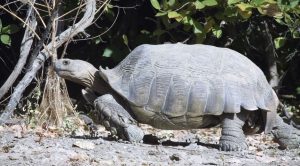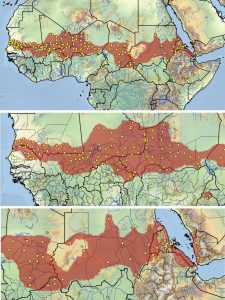Centrochelys sulcata, 110
Centrochelys sulcata (Miller 1779) –
African Spurred Tortoise, Grooved Tortoise, Sahel Tortoise, Tortue Sillonnée
Fabio Petrozzi1, Emmanuel M. Hema2, Gift Simon Demaya3,
John Sebit Benansio3, Edem A. Eniang4, Tomas Diagne5,
Gabriel Hoinsoudé Segniagbeto6,7, and Luca Luiselli6,7,8
1Ecolobby, via Aretina 142, 50136 Rome, Italy [[email protected]];
2Université Ouaga 1 Professeur Joseph Ki Zerbo/CUP-D, Laboratoire de Biologie et Ecologie Animales, Ouagadougou, Burkina Faso [[email protected]];
3Department of Wildlife, University of Juba, South Sudan [[email protected]; [email protected]];
4Department of Forestry and Wildlife, University of Uyo, Uyo, Akwa-Ibom State, Nigeria [[email protected]];
5African Chelonian Institute, BP 80 Joal, Thies 23015, Senegal [[email protected]];
6Laboratory of Ecology and Ecotoxicology, Faculty of Sciences, University of Lomé, BP 6057, Lomé, Togo [[email protected]];
7Institute for Development, Ecology, Conservation and Cooperation, via G. Tomasi di Lampedusa 33, 00144 Rome, Italy [[email protected]];
8Department of Applied and Environmental Biology, Rivers State University of Science and Technology, PMB 5080, Nkpolu, Port Harcourt, Rivers State, Nigeria
Summary. – Centrochelys sulcata, the African Spurred Tortoise (Family Testudinidae) is one of the largest terrestrial chelonians in the world, the largest extant continental tortoise, and the largest tortoise in Africa. Males are larger than females, and may exceed 100 kg in body mass, with a straight carapace length of up to 86.0 cm in males and 57.8 cm in females, and a curved carapace length reaching 101.0 cm in males and 67.0 cm in females. The species has a wide geographic distribution across the arid savannahs of the Sahelian regions of sub-Saharan Africa, but with many gaps in its range, and reaches the southern tip of the Arabian Peninsula. The sex ratio is nearly equal and sexual maturity is reached at 10–15 years. The species is especially linked to habitat with periodic or intermittent streams and rivers, locally called kori in the Sahelian regions. In addition, African Spurred Tortoises can be found on slopes and hills, in particular on stabilized dunes, and sporadically in flat areas with semi-deciduous shrublands and high grasses. Cattle grazing has a negative effect on the presence of this species, especially when grazing areas are created with seasonal fires. The species is mostly herbivorous, but can feed on carrion on occasion and on garbage in the surroundings of human settlements. Males are highly territorial, with larger males winning sexual combats. The population density is among the lowest that has been observed so far in terrestrial chelonians. The species makes extensive use of deep and long burrows (up to 15 m long), occasionally used by more than one individual, and above-ground activity is mainly concentrated in the early morning hours and during the wet season (August). Reproduction is also seasonal, with matings occurring primarily in September to April. Nesting occurs from September to May, during which 2–3 clutches of 14–40 eggs (average egg ca. 52 x 44 mm, 55 g) are laid. The species is declining rapidly due to a plethora of reasons, including habitat loss, exploitation for eggs and meat as well as for the international pet trade, and the effects of climate change, but since it is easy to breed in captivity and is frequently bred by local communities, there is significant potential for reintroduction programs, some of which have already been initiated in Senegal.
Distribution. – Benin, Burkina Faso, Cameroon (likely extirpated), Central African Republic, Chad, Eritrea, Ethiopia, Mali, Mauritania, Niger, Nigeria, Saudi Arabia, Senegal, Sudan, and Yemen. Possibly previously present in Djibouti (extirpated?), Togo (extirpated?), and Somalia.
Synonymy. – Testudo sulcata Miller 1779, Geochelone (Geochelone) sulcata, Geochelone sulcata, Peltastes sulcatus, Centrochelys sulcatus, Centrochelys sulcata, Testudo calcarata Schneider 1784 (nomen novum), Chersine calcarata, Testudo radiata senegalensis Gray 1831, Geochelone senegalensis, Geochelone sulcata senegalensis, Testudo schoepfii Rüppell in Gray 1873 (nomen nudum), Geochelone sulcata sudanensis Ballasina, Vandepitte, Mochi, and Fenwick 2006 (nomen nudum).
Subspecies. – None currently recognized.
Status. – IUCN 2020 Red List Status: Vulnerable (VU A1cd, assessed 1996); TFTSG Provisional Red List: Endangered (EN, assessed 2013); CITES: Appendix II (as Testudinidae spp.).
Citation:
Petrozzi, F., Hema, E.M., Demaya, G.S., Benansio, J.S., Eniang, E.A., Diagne, T., Segniagbeto, G.H., and Luiselli, L. 2020. Centrochelys sulcata (Miller 1779) – African Spurred Tortoise, Grooved Tortoise, Sahel Tortoise, Tortue Sillonnée. In: Rhodin, A.G.J., Iverson, J.B., van Dijk, P.P., Stanford, C.B., Goode, E.V., Buhlmann, K.A., and Mittermeier, R.A. (Eds.). Conservation Biology of Freshwater Turtles and Tortoises: A Compilation Project of the IUCN/SSC Tortoise and Freshwater Turtle Specialist Group. Chelonian Research Monographs 5(14):110.1–16. doi: 10.3854/crm.5.110.sulcata.v1.2020; www.iucn-tftsg.org/cbftt/.
Adobe Acrobat 6.0 or later required)
Adult male Centrochelys sulcata from Katane, Senegal.
Photo by Tomas Diagne.
Distribution:
Distribution of Centrochelys sulcata in sub-Saharan Africa and the Arabian Peninsula. Top: Entire range, middle: western range, bottom: eastern range. Yellow dots = museum and literature occurrence records of native populations based on Iverson (1992) plus more recent and authors’ data; orange dots = uncertain native or introduced or trade specimens (see Devaux 2000b); red shading = presumed indigenous range (see also Devaux 2000b). Distribution based on GIS-defined level 10 HUCs (hydrologic unit compartments) constructed around verified localities and then adding HUCs that connect known point localities in the same watershed or physiographic region, and similar habitats and elevations as verified HUCs (Buhlmann et al. 2009; TTWG 2017), and adjusted based on authors’ subsequent data.










